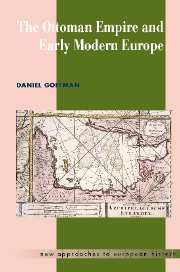Book contents
- Frontmatter
- Contents
- List of illustrations
- List of maps
- Preface
- Acknowledgements
- Note on usage
- Chronological table of events
- The Ottoman House through 1687
- 1 Introduction: Ottomancentrism and the West
- Part 1 State and society in the Ottoman world
- Part 2 The Ottoman Empire in the Mediterranean and European worlds
- Kubad in Venice
- 5 The Ottoman–Venetian association
- Kubad between worlds
- 6 Commerce and diasporas
- Kubad ransomed
- 7 A changing station in Europe
- 8 Conclusion: The Greater Western World
- Glossary
- Suggestions for further reading
- Index
- NEW APPROACHES TO EUROPEAN HISTORY
Kubad between worlds
from Part 2 - The Ottoman Empire in the Mediterranean and European worlds
Published online by Cambridge University Press: 05 June 2012
- Frontmatter
- Contents
- List of illustrations
- List of maps
- Preface
- Acknowledgements
- Note on usage
- Chronological table of events
- The Ottoman House through 1687
- 1 Introduction: Ottomancentrism and the West
- Part 1 State and society in the Ottoman world
- Part 2 The Ottoman Empire in the Mediterranean and European worlds
- Kubad in Venice
- 5 The Ottoman–Venetian association
- Kubad between worlds
- 6 Commerce and diasporas
- Kubad ransomed
- 7 A changing station in Europe
- 8 Conclusion: The Greater Western World
- Glossary
- Suggestions for further reading
- Index
- NEW APPROACHES TO EUROPEAN HISTORY
Summary
Anyone who saw the Venetians, a tiny nation living in such liberty that the worst rogue among them would not wish to be their king, … anyone, I say, who saw those people and then went to the realm of the man we call the Grand Signor, and saw how people there reckon that the sole purpose of their existence is to serve this man … would he reckon that these two nations shared a common nature, or would he not rather judge that he had left a city and entered a sheepfold?
Kubad finally left Venice on 12 February 1568. Even though he would have preferred the speedy and convenient journey by sea across the Adriatic and Aegean seas, he chose instead the land route from Dubrovnik and via Sarajevo and Edirne because of escalating strikes by Uskok and Maltese pirates against Ottoman shipping. Back in Istanbul he reported to his lords in the Imperial Divan and fulfilled his promise to the Venetian Senate by arranging for the obliteration of all references to Soranzo's contract with di Segura. He even convinced the kadi of Galata to tear his copy of the vexing certificate out of his ledger and burn it.
Kubad's willingness to undertake this unlawful act derived partly from expectations for future rewards. Venetian relief at no longer being liable to Ottoman justice was enormous and a grateful bailo compensated the courier well. There was a darker cause, however.
- Type
- Chapter
- Information
- The Ottoman Empire and Early Modern Europe , pp. 165 - 168Publisher: Cambridge University PressPrint publication year: 2002

